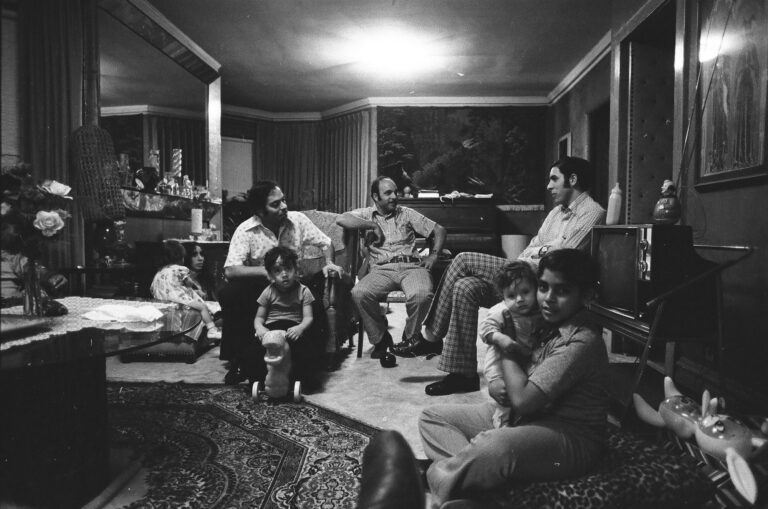In 2024, the holy month of Ramadan began for many Muslims at sundown on Sunday, March 10. CHM curator of religion and community history Rebekah Coffman talks about the significance of iftar, an important part of Ramadan.

Friends and family gather for iftar, September 28, 1974. ST-10104872-0014, Chicago Sun-Times collection, CHM
The Islamic month of Ramadan is a time of prayer, fasting, and personal and community reflection. The ninth and holiest month of the Hijri, it is a time when Muslims around the world will fast daily from sunrise to sunset, fulfilling one of the five central tenets of Islam in commemoration of the Quran’s revelation to Muhammed.

The kids’ table at iftar, September 28, 1974. ST-10104872-0027, Chicago Sun-Times collection, CHM
Each evening, after Magrib (evening prayer), communities and families come together for iftar, a meal to break the day’s fast. This includes preparing and eating delicious foods and desserts and is also a time for music, telling stories, playing games, and spending time in each other’s company, passing traditions down through generations. These communal moments were recognized in 2023 as globally significant Intangible Cultural Heritage by the United Nations Educational, Scientific and Cultural Organization (UNESCO), noting how vitally important sharing rituals like iftar can be to maintaining and preserving cultural traditions.

Screenshot of UNESCO’s interactive constellation map of different types of intangible cultural heritage, 2024.
Intangible heritage refers to living traditions beyond monuments and collections and is embodied through oral traditions, rituals, festive events, social practices, and knowledge. It is heritage expressed through living action that bridges the past with the present, and in religious contexts is also known as “living religious heritage.” Many examples of rituals and foods are recognized and celebrated as intangible heritage today, with more being added to our shared global heritage. UNESCO does not currently include the United States in its official lists for recognized intangible heritage, but traditions and rituals remain transnational ways of keeping intangible heritage alive among communities.

Friends and family at iftar, September 28, 1974. ST-10104872-0005, Chicago Sun-Times collection, CHM
A local example of these intangible moments was captured in a series of photographs for the Chicago Sun-Times in 1974. Religion reporter Roy Larson wrote about his experience attending an iftar at the home of Chicagoans Donna and Abraham Mohammed. Joined by family and friends, including the Abu-Shalbacks, the mealtime discussion centered on Palestinian heritage and what the idea of “home” means to them. Larson describes the beautiful meal that was shared, including maqluba, a traditional Arab/Palestinian dish of meat, rice, and vegetables that is cooked and then flipped onto a dish when served. In the spirit of sharing, the Abu-Shalbacks’ then-twelve-year-old son, Sami, invited Larson to his class at 55th Street and Fairfield Avenue in Gage Park to study Arabic and the Quran.

Family and friends sharing an iftar meal, September 28, 1974. ST-10104872-0012, Chicago Sun-Times collection, CHM
In the 1970s, there were approximately 25,000–35,000 Muslims in Chicago. Chicago’s burgeoning Palestinian diaspora was then centered in the Gage Park and Chicago Lawn neighborhoods on the Southwest Side. Today, there are 350,000 Muslims in Illinois, most living in the Chicagoland area, making it the highest concentration of Muslims in the country. The Palestinian diaspora is a vital part of the community, with more Palestinians living in Cook County than elsewhere in the United States. Suburban areas such as Oak Lawn, Orland Park, and Bridgeview have become the heart of Chicagoland’s Palestinian community with the stretch of Harlem Street from 79th to 123rd earning the moniker “Little Palestine.”

Mosque Foundation in Bridgeview, Illinois, 2024. Photograph by Rebekah Coffman

The Prayer Center of Orland Park in Orland Park, Illinois, June 26, 2019. Photograph by Tim Paton. CHM, ICHi-175817
One of our previous exhibitions, American Medina: Stories of Muslim Chicago (October 21, 2019–May 16, 2021), preserved and shared a wide range of Muslim voices, perspectives, and traditions, demonstrating the diverse Muslim communities that call Chicago home today. This includes more than 140 oral histories, many of which are available to listen to through SoundCloud and research via our online database, including memories of Ramadan and perspectives from other Palestinian Chicagoans.
Additional Resources
- Read the Encyclopedia of Chicago entry on Muslims
- Read the Encyclopedia of Chicago entry on Palestinians
- Peruse the Muslim Oral History Project interviews on ContentDM
- Listen to interviews from American Medina: Stories of Muslim Chicago on SoundCloud